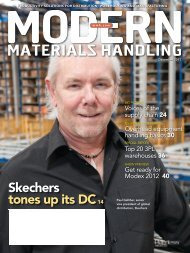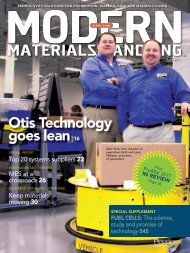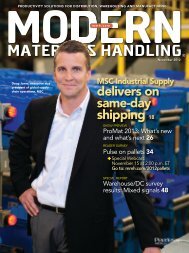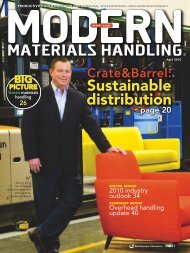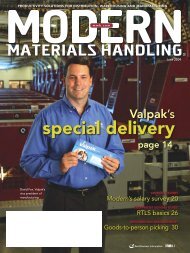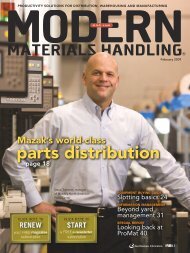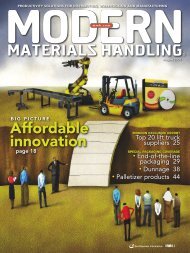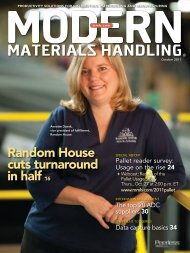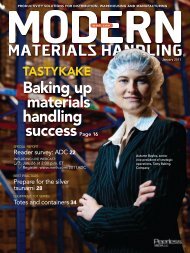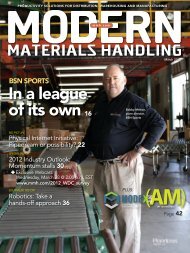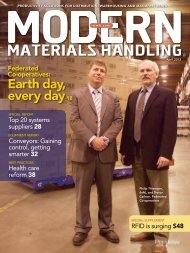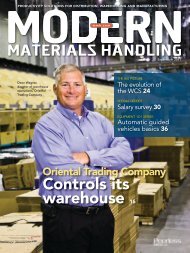Create successful ePaper yourself
Turn your PDF publications into a flip-book with our unique Google optimized e-Paper software.
modern SYSTEM REPORT<br />
As part of an allergan prevention<br />
program, the WMS system manages<br />
the storage of raw nuts by type.<br />
innovation was mechanical shelling,<br />
which was introduced in the 1960s,”<br />
says Sanfilippo. “That meant that fewer<br />
home-based families were needed to do<br />
the shelling.”<br />
In 1964, Sanfilippo’s father took over<br />
the company and diversified into other<br />
tree nuts, including walnuts, cashews,<br />
almonds and macadamia nuts. In the<br />
late 1960s, the company also shipped<br />
its first private label product, an 8ounce<br />
bag of pecans, to the Chicagobased<br />
grocer Dominick’s Finer Foods.<br />
As the private label business grew, the<br />
company expanded. In the late 1980s,<br />
Sanfilippo & Son built a peanut plant<br />
in Georgia and added walnut, in-shell<br />
peanut and almond processing plants.<br />
In 1991, the company went public, and<br />
in 1995, it purchased the Fisher Nuts<br />
brand from Proctor & Gamble. Today,<br />
the company processes an average of<br />
600,000 pounds of nuts each day, and<br />
ships 375,000 cases of nuts per week<br />
during peak season.<br />
The WMS brings together raw<br />
materials and packaging products<br />
during processing.<br />
By <strong>20</strong>05, the company’s operations<br />
were spread across five different facilities<br />
in a 10-mile square area in suburban<br />
Chicago. “There are logistical<br />
challenges when you’re sending raw<br />
materials from two warehouses to three<br />
different manufacturing facilities,” says<br />
Sanfilippo. “Especially when you’re<br />
trying to control your inventory with a<br />
manual system.”<br />
What’s more, the company was<br />
bumping up against capacity constraints<br />
that would hinder its ability to continue<br />
to grow. “We needed space so we could<br />
increase the capacity of our existing line<br />
without increasing our overhead, and<br />
we needed to standardize processes for<br />
quality control reasons,” adds Kirkham.<br />
“If you’re operating in five buildings, it’s<br />
not hard to end up with five different<br />
processes.”<br />
The company had already purchased<br />
land and was working with consultants<br />
on the design of a new headquarters<br />
when a 1.06 million square foot building,<br />
formerly owned by Panasonic,<br />
came up for sale in Elgin, Ill., including<br />
400,000 square feet of office space and<br />
about 650,000 square feet of manufacturing<br />
space. In the end, reconfiguring<br />
an existing space was faster and more<br />
efficient than building a new space.<br />
Selecting a WMS<br />
From a materials handling standpoint,<br />
designing the new facility was relatively<br />
straight-forward. The manufacturing<br />
area relies on specialized and proprietary<br />
processes and equipment.<br />
When it came to warehousing, raw<br />
materials and finished goods are primarily<br />
handled on pallets with lift trucks<br />
18 A PRIL <strong>20</strong>09 / MODERN MATERIALS HANDLING mmh.com



